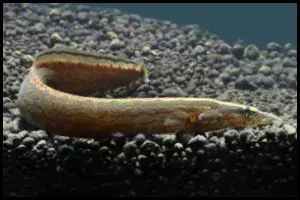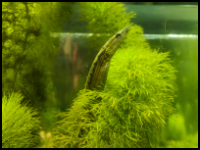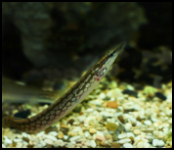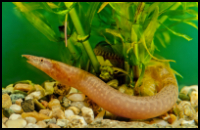




Quick Care Details (Table)
| Livestock Characteristics | Value |
|---|---|
| Care Level | Moderate |
| Temperament | Semi-Aggressive |
| Diet | Carnivore |
| Maximum Size | 2ft & 6 Inches |
| Minimum Tank Size | 125 Gallons |
| Plant Safe | Yes |
| Temperature Range | 72-82F |
| PH Range | 6.8-7.2 |
| KH Range | 10-16 |
Species Specific Categories
Helpful Video
Care Details
Aquascape: Creating a suitable aquascape for Tire Track Eels is essential. They need plenty of hiding spots, so include caves, PVC pipes, or hollow driftwood to mimic their natural burrowing behavior. Dense vegetation may not be necessary, but floating plants can help diffuse lighting and provide some cover.
Substrate: Choose a fine, sandy substrate to accommodate their burrowing tendencies. A layer of 2-3 inches of sand allows them to bury themselves comfortably. Avoid rough gravel or sharp substrates to prevent injury.
Disease Prevention: Maintaining pristine water quality is crucial for disease prevention. Perform regular water changes, monitor water parameters, and ensure that tankmates are healthy. Quarantine new additions to prevent the introduction of diseases.
Filtration: Use a powerful filter to maintain water quality, but ensure that the filter intake is well-protected to prevent the eel from getting trapped. Moderate to high filtration is essential to remove waste and maintain good water conditions.
Lighting: Tire Track Eels are nocturnal and do not require intense lighting. Subdued or dim lighting helps them feel secure, as they may become stressed in brightly lit tanks.
Water Flow: These eels don't appreciate strong water flow. Aim for gentle or minimal water movement to mimic their natural habitat.
Hardiness: Tire Track Eels are relatively hardy if water conditions are stable and appropriate. However, they are sensitive to changes in water quality, so consistent maintenance is vital.
Acclimation: When introducing Tire Track Eels to a new tank, acclimate them slowly to minimize stress and temperature shock. Gradually mix tank water with the water they arrived in to help them adjust.
Expected Lifespan: With proper care, Tire Track Eels can live for 10-15 years or more in captivity, making them a long-term commitment.
Special Requirements: Tire Track Eels require hiding places, sandy substrate, and careful acclimation. They are solitary by nature, so avoid housing them with aggressive or territorial tankmates. Provide a varied diet of live and frozen foods to ensure their nutrition.
Temperament and Behavior
Behavior: Tire Track Eels are known for their intriguing behavior. They are primarily nocturnal and spend much of their time buried in the substrate, leaving only their heads and upper bodies exposed. At night, they become more active, swimming and foraging for food. These eels are generally solitary and can be secretive, so providing hiding spots and quiet surroundings is crucial for their well-being.
Breeding: Breeding Tire Track Eels in captivity is challenging and rare. They are difficult to sex, and little is known about their reproductive behaviors. In the wild, they are known to migrate to specific breeding areas, but reproducing them in an aquarium is a complex task that requires precise conditions.
Aggression: Tire Track Eels are not inherently aggressive but can become territorial, especially when they feel threatened or during breeding. It's advisable to keep them in a single-species setup to avoid conflicts.
Tankmates Compatibility: Choose tankmates carefully. Compatible options include peaceful, non-aggressive species that won't compete for the same territory. Some suitable companions are smaller, non-predatory fish, such as peaceful tetras, catfish, or similarly sized species that prefer different areas of the tank.
Activity Level: Tire Track Eels are primarily nocturnal, and their activity level increases after dark. During the day, they prefer to bury themselves in the substrate or hide in caves, so don't be alarmed if you don't see them during daylight hours.
Schooling or Shoaling Behavior: Tire Track Eels are solitary creatures and do not exhibit schooling or shoaling behavior. They prefer to lead independent lives, and it's best to keep them singly in an aquarium.
Plant Compatibility: Tire Track Eels do not typically damage or uproot aquatic plants since they spend most of their time buried in the substrate. However, choose hardy plants, as they may accidentally dislodge smaller ones during their burrowing.
Diet and Nutrition
Dry Foods: Tire Track Eels are primarily carnivorous and may not readily accept dry foods. However, some individuals can be trained to eat sinking pellets or granules. To ensure a balanced diet, offer high-quality sinking pellets or sticks specifically designed for carnivorous fish. It's essential to monitor their acceptance of dry foods and supplement their diet with other options.
Frozen Foods: Tire Track Eels have a strong preference for frozen foods, especially meaty options like bloodworms, brine shrimp, and krill. These provide essential nutrients and are excellent choices for their main diet. Offer them in small, bite-sized portions, as eels have relatively small mouths.
Live Foods: Live foods such as live blackworms, small feeder fish, and aquatic insects are highly appreciated by Tire Track Eels. They exhibit natural hunting behavior and enjoy chasing live prey. These foods add mental stimulation and mimic their hunting instincts.
Vegetables: Tire Track Eels are predominantly carnivorous and do not have a significant interest in vegetables. Offering vegetables is generally unnecessary for their diet, and they may ignore them.
Algae: Tire Track Eels are not herbivorous and do not consume algae. They are unlikely to contribute to algae control in your tank.
Feeding Schedule: Feed adult Tire Track Eels every 2-3 days to prevent overfeeding and water quality issues. Offer a mix of frozen and live foods, as well as occasional dry foods, to ensure they receive a varied and balanced diet. Younger eels may require more frequent feedings.
Supplemental Foods: To enhance their diet, consider using supplements like vitamin-enriched foods or calcium supplements to maintain their overall health. These can be beneficial, especially for captive eels that might not have access to a fully natural diet.
Tank Parameters
Tank Size: Tire Track Eels require a spacious aquarium due to their elongated bodies. A tank of at least 75 gallons (around 284 liters) is recommended for a single adult eel. Keep in mind that larger tanks can provide a more comfortable environment for these eels, as they are known to grow quite long.
Tank Length and Measurements: The tank should be long to accommodate their sinuous nature. A 4-foot (approximately 120 cm) or longer tank is ideal. The width should be sufficient to allow them to turn around comfortably, and the height should consider the water depth and available hiding spots.
Water Temperature: Maintain a water temperature between 75-82°F (24-28°C) for Tire Track Eels. Aim for a stable temperature within this range to keep them healthy and comfortable.
pH (Acidity/Alkalinity): Tire Track Eels prefer slightly acidic to neutral water conditions. Aim for a pH level between 6.5 and 7.5 to mimic their natural habitat.
KH (Carbonate Hardness): The carbonate hardness (KH) should be moderate, typically within the range of 3-8 dKH. This range is suitable for most freshwater fish, including Tire Track Eels.
GH (General Hardness): Maintain a general hardness (GH) level between 5-15 dGH, ensuring that the water is not too soft or too hard. This range provides a suitable mineral content for the eels.
Hardiness: Tire Track Eels are relatively hardy when kept in stable water conditions with appropriate parameters. However, they can be sensitive to rapid changes in water quality, so regular maintenance and monitoring are crucial.
Nitrate (NO3) Levels: Keep nitrate levels below 20 ppm (parts per million) to ensure good water quality. Regular water changes and effective filtration are necessary to manage nitrate levels and maintain a healthy environment for Tire Track Eels.
History, Popularity, History and Species Variety Details
The History, Popularity and Natural Habitat
History: The Tire Track Eel, scientifically known as Mastacembelus armatus, is an extraordinary fish species hailing from the waters of Southeast Asia. It has a storied history within the aquarium community, where it has captured the imaginations of fish enthusiasts for many years. The name "Tire Track Eel" is derived from the distinctive tire-like pattern adorning its body. This eel-like fish, with its sinuous form and inquisitive personality, has become a fixture in aquariums, beloved by both novice and seasoned aquarists.
Popularity: The Tire Track Eel's allure lies in its unique appearance and captivating behavior. Its elongated body, marked by tire track-like patterns, along with its penchant for burrowing, has propelled it to the top of many aquarium wish lists. While its care requirements can be specific, the Tire Track Eel's singular characteristics make it a treasured addition to aquariums seeking to showcase the extraordinary in aquatic life.
Natural Habitat: In its native habitat, the Tire Track Eel calls the slow-moving or still waters of Southeast Asia home, particularly in countries like Thailand, Cambodia, and Vietnam. These eels prefer freshwater environments, often in rivers, swamps, and marshes, with muddy or sandy substrates. They are renowned for their burrowing tendencies, finding refuge among submerged plants and natural debris. Replicating these conditions in an aquarium setting is pivotal to their well-being.
Understanding the history, popularity, and natural habitat of the Tire Track Eel provides a deeper appreciation for why it's a captivating choice among aquarists who value its distinctive attributes and are eager to provide the necessary care.
Frequently Asked Questions
Are Tire Track Eels suitable for beginners?
Tire Track Eels are not the best choice for beginners due to their unique care requirements. Experience with other aquarium fish is beneficial before considering these eels.
What's the minimum tank size for a Tire Track Eel?
A tank of at least 75 gallons is recommended for a single adult Tire Track Eel to provide ample space for their burrowing and growth.
Can Tire Track Eels be kept together in the same tank?
It's advisable to keep Tire Track Eels singly. They are territorial and may not tolerate others of their kind or similar species.
What should I feed my Tire Track Eel?
Offer a diet of live and frozen meaty foods like bloodworms, brine shrimp, and small fish. Dry foods can be supplemented but may not be readily accepted.
Do they need hiding spots in the tank?
Yes, Tire Track Eels require caves, hollow driftwood, or PVC pipes for hiding and burrowing. Providing hiding spots is essential for their well-being.
How can I prevent escapes from the tank?
To prevent escapes, ensure the tank has a secure lid or cover. Tire Track Eels are known to be skilled at escaping if given the opportunity.
What water parameters do they prefer?
Maintain stable water conditions with a temperature of 75-82°F, pH between 6.5-7.5, KH of 3-8, and GH of 5-15. Regular water quality monitoring is crucial.
Can they coexist with other fish in a community tank?
Choose tankmates carefully. Peaceful, non-aggressive species that won't compete for the same territory are ideal companions. Avoid aggressive or predatory fish.
How long do Tire Track Eels live in captivity?
With proper care, Tire Track Eels can live up to 15 years or more, making them a long-term commitment for aquarists.
What's their activity level during the day?
Tire Track Eels are primarily nocturnal, so they're more active at night. During the day, they often burrow or hide in their chosen spots.

